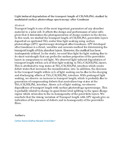| dc.contributor.author | Awino, Celline | |
| dc.contributor.author | Barasa, Godfrey | |
| dc.contributor.author | Odari, Victor | |
| dc.date.accessioned | 2021-07-07T13:22:21Z | |
| dc.date.available | 2021-07-07T13:22:21Z | |
| dc.date.issued | 2020-02 | |
| dc.identifier.uri | https://doi.org/10.1016/j.orgel.2019.105503 | |
| dc.identifier.uri | https://www.sciencedirect.com/science/article/abs/pii/S1566119919305300?via%3Dihub#! | |
| dc.identifier.uri | http://r-library.mmust.ac.ke/123456789/1754 | |
| dc.description.abstract | Transport length is one of the most important parameters of any absorber material in a solar cell. It affects the design and performance of solar cells given that it determines the photogeneration of charge carriers in the device. In this work, we studied the transport length of CH3NH3PbI3 perovskite layers deposited on sputtered TiO2 under blue light soaking using surface photovoltage (SPV) spectroscopy developed after Goodman. SPV developed after Goodman is a direct, sensitive and accurate method for determining the transport length of thin absorber layers. However, the method has been inadequately utilized. In the study, we used blue light for light soaking due to its short wavelength that can probe the surface properties of the perovskite layers in comparison to red light. We observed light induced degradation of transport length within 12 h of blue light soaking in TiO2/CH3NH3PbI3 layers. This is attributed to trap states at TiO2/CH3NH3PbI3 interface which create defect states that increases the recombination rate. In addition, the decrease in the transport length within 12 h of light soaking can be due to the charging and discharging effects at TiO2/CH3NH3PbI3 interface. With prolonged light soaking, we observe an increase in transport length, which is probably due to generation of compensating defects that neutralizes trap states at the TiO2/CH3NH3PbI3 interface. Above 12 h of light soaking, we observe dependence of transport length with surface photovoltage spectroscopy. This is probably related to change in quasi fermi level splitting in the space charge region which arises due to the in-homogeneity of the perovskite layers. We conclude that the strong variation of Transport length with SPV signals give an indication of the presence of defects and in-homogeneity of the perovskite films. | en_US |
| dc.language.iso | en | en_US |
| dc.publisher | Science Direct | en_US |
| dc.subject | Light, induced, degradation , transport, length, CH3NH3PbI3 ,studied, modulated, surface, photovoltage, spectroscopy, Goodman | en_US |
| dc.title | Light induced degradation of the transport length of CH3NH3PbI3 studied by modulated surface photovoltage spectroscopy after Goodman | en_US |
| dc.type | Article | en_US |

